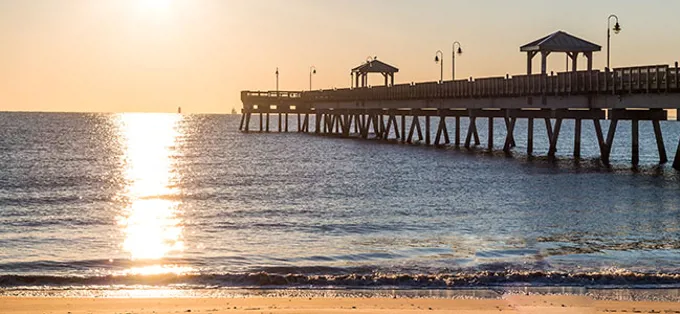
Riparian Rights for Establishing a Riparian Area Under Virginia Law
What is a riparian area?
Each waterfront property has a unique riparian area that is formed by the shore on one side and by the line of navigation on the other side. The side boundaries of the riparian area extend out from the shoreline to the line of navigation, but these lines are not necessarily a straight extension of the upland property lines. Determining the riparian area for a waterfront property often requires a combination of efforts from a hydrographic surveyor and a riparian property rights attorney. Our Waterfront Property Law team is very experienced in establishing riparian areas in Virginia. So let's take a deep look a how to establish a riparian area.
Why does a riparian area matter?
The waterfront property owner may exercise his/her riparian property rights only within the boundary of the riparian area.
The size and shape of the riparian area is unique to each waterfront property
Virginia law entitles a waterfront property owner to exercise his or her riparian property rights within the boundaries of the riparian area. The size and shape of the riparian area is unique to each waterfront property.
Under Virginia law, only a Court can establish the riparian area for a waterfront property.
The first step is to consult a riparian property rights attorney and have that attorney recommend a hydrographic surveyor (we have established relationships with reputable hydrographic surveyors). The riparian property rights attorney and the hydrographic surveyor work together, using the instructions in the legal cases for charting the riparian area. Together they prepare a chart showing the boundaries of the riparian area for the specific waterfront property. Once this process is complete, the riparian property rights attorney initiates the legal action in the Circuit Court in Virginia with jurisdiction over the particular waterfront property. If uncontested by the neighboring property owners, the legal process can finish in 60-90 days. If the process is contested, the time required and the associated cost are higher (conflict among neighboring property owners can drive the cost substantially higher).
The riparian area has four boundaries
The first boundary is the length of the shore at the waterfront property. This length is easily determinable because it is a line that follows the mean low water mark at the property. However, in the calculations made to lay out the riparian area, the shore at some of the adjoining waterfront properties will be paired up with the shore at the waterfront property that is of interest, to come up with a length of overall “shoreline”. The number of adjoining waterfront properties that must be paired up with the waterfront property of interest, to make up the overall length of shoreline that is used in the calculation, depends on the shape of the shoreline and on other geographic features.
The opposite boundary is the line of navigation. The location and shape of this line will depend on a variety of factors such as the shape of the shoreline, the size of the waterbody, whether there is a marked channel, etc. After taking these factors into account, another factor that will cause the line of navigability to shift in one direction or another is the bottom depth contour lines that are charted during the hydrographic survey. A specific bottom depth contour will be chosen for the line of navigability. In some situations the two-foot bottom depth contour might be selected. Something in the range of two-and-one-half feet to four feet is typical in a residential setting. In one of the legal cases the seven-foot bottom depth contour was used. Establishing the line of navigability can be complex and can introduce a lot of variation into the size and shape of the riparian area, depending on the selections made from among these various factors.
Once the length of the waterfront property owner’s shore is established (this is simple), the length of the shoreline is established (this is complex), and the length of the line of navigation is established (this is complex), laying out all four boundaries of the riparian area is done with a simple mathematical calculation.
There is a lot of room for argument when establishing the length of the shoreline and the line of navigation. In the end it will be a Court that decides these things. A waterfront property owner who wants to increase the odds of gaining a favorable reception at Court with respect to his or her preferred interpretation should have this entire process managed by a riparian property rights attorney and a reputable hydrographic surveyor working under the supervision of the riparian property rights attorney.
What are Riparian Property Rights?
As we've explained elsewhere, riparian property rights refers to a system of property rights that give waterfront property owners the right to use water and bottomland in the riparian area adjacent to their property. Waterfront property owners often pay a premium to acquire waterfront property, because they have ownership of the land above the low-water mark and also own riparian property rights in the riparian area adjacent to the land. These riparian property rights are a package of five specific benefits available under Virginia law. Preparing a hydrographic survey is an important part of the process in determining a waterfront property’s riparian area. This survey should be conducted by a hydrographic surveyor under the supervision of a riparian property rights attorney.
Riparian Area Definition
A riparian area is determined under Virginia law using a complex formula which first measures the length of a property owner’s shoreline, plus the shorelines of those neighboring properties that must be included, then measures the length of the “line of navigability”, and then uses a mathematical formula to apportion the “line of navigability” among the participating waterfront properties. Mapping the riparian area is important because the waterfront property owner exercises his or her riparian property rights only within the boundaries of the riparian area.
What are surface water rights in Virginia?
In the state of Virginia, the waterfront property owner is entitled to use but does not necessarily own the water next to his or her property. As explained in another article in this blog, the right of the waterfront property owner to control activities on the water is greatest when he or she also owns the bottomland beneath the water. In this situation, the waterfront property owner may be able to stop others from boating, swimming, fishing or otherwise using the surface water. If the Commonwealth of Virginia owns the bottomland then the surface water is a resource shared with the public. This means that the public can boat, swim and fish in these types of surface waters. When it comes to discharging pollution into surface water, a permit is required from the Virginia Department of Environmental Quality (“DEQ”) no matter who owns the bottom land. Similarly, a permit from the DEQ may also be required in some situations if the waterfront property owner wants to withdraw surface water from the waterbody.
Need Help Determining your Riparian Area? We’re standing by and ready to help navigate your unique situation - Click here to Schedule Your Consultation.
